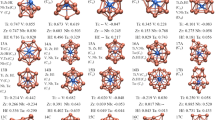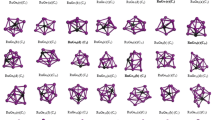Abstract
Determining the structures of germanium clusters can assist in comprehending the origins of the structures and properties of germanium bulk. As a result, it can pave the way for designing semiconductor materials with exceptional properties. Herein, we investigated the structural evolution and electronic properties of germanium clusters Gen− (n = 4–30) at density functional theory (DFT) level. Low-lying isomers of these clusters have been globally searched by using a homemade genetic algorithm coupled with DFT calculations. The ground-state structures of all these Ge cluster anions have been identified by comparing the experimental and simulated photoelectron spectra (PES). In the studied size range of n = 4–30, the Ge clusters follow a simple growth pattern. From Ge4− to Ge9−, a nine-atom tricapped trigonal prism (TTP) is stepwisely formed. The resulting TTP unit is then capped with the remaining excess atoms in the size range of n = 10–17. Ge18− to Ge30− result from two TTP units by incorporation of additional adatoms into the waist. The vertical detachment energy (VDE) curve for Gen− displays a general increasing trend, while the HOMO–LUMO gap results are in an opposite trend. The average binding energies increase as the size increases, indicating that it is conducive to the formation of large clusters. It is found that sizes n = 7, 10, 13, 15 are the magic numbers.




Similar content being viewed by others
Data availability
The data used to support the findings of this study are available from the corresponding author upon request.
References
A. Kant, B.H. Strauss, Atomization energies of the polymers of germanium, Ge2 to Ge7. J. Chem. Phys. 45, 822–826 (1966)
T.P. Martin, H. Schaber, Mass spectra of Si, Ge, and Sn clusters. J. Chem. Phys. 83, 855–858 (1985)
S. Yoshida, K. Fuke, Photoionization studies of germanium and tin clusters in the energy region of 5.0–8.8 eV: ionization potentials for Gen (n = 2–57) and Snn (n = 2–41). J. Chem. Phys. 111, 3880–3890 (1999)
O. Cheshnovsky, S.H. Yang, C.L. Pettiette, M.J. Craycraft, Y. Liu, R.E. Smalley, Ultraviolet photoelectron spectroscopy of semiconductor clusters: silicon and germanium. Chem. Phys. Lett. 138, 119–124 (1987)
Y. Negishi, H. Kawamata, T. Hayase, M. Gomei, R. Kishi, F. Hayakawa, A. Nakajima, K. Kaya, Photoelectron spectroscopy of germanium-fluorine binary cluster anions: the HOMO–LUMO gap estimation of Gen clusters. Chem. Phys. Lett. 269, 199–207 (1997)
Y. Negishi, H. Kawamata, F. Hayakawa, A. Nakajima, K. Kaya, The infrared HOMO–LUMO gap of germanium clusters. Chem. Phys. Lett. 294, 370–376 (1998)
H.-L. Xu, N.V. Tkachenko, D.W. Szczepanik, I.A. Popov, A. Muñoz-Castro, A.I. Boldyrev, Z.-M. Sun, Symmetry collapse due to the presence of multiple local aromaticity in Ge244−. Nat. Commun. 13, 2149 (2022)
S. Ö̆güt, J.R. Chelikowsky, Structural changes induced upon charging Ge clusters. Phys. Rev. B 55, R4914–R4917 (1997)
J. Wang, G. Wang, J. Zhao, Structure and electronic properties of Gen (n = 2–25) clusters from density-functional theory. Phys. Rev. B 64, 205411 (2001)
S. Yoo, X.C. Zeng, Search for global-minimum geometries of medium-sized germanium clusters. II. Motif-based low-lying clusters Ge21–Ge29. J. Chem. Phys. 124, 184309 (2006)
L. Wang, J. Zhao, Competition between supercluster and stuffed cage structures in medium-sized Gen (n = 30–39) clusters. J. Chem. Phys. 128, 024302 (2008)
D. Wu, R. Shi, Q. Du, X. Wu, X. Liang, X. Huang, L. Sai, J. Zhao, Atomic structures and electronic properties of large-sized GeN clusters (N = 45, 50, 55, 60, 65, 70) by first-principles global search. J. Cluster Sci. 30, 371–377 (2019)
W.-C. Lu, C.Z. Wang, L.-Z. Zhao, W. Zhang, W. Qin, K.M. Ho, Appearance of bulk-like motifs in Si, Ge, and Al clusters. Phys. Chem. Chem. Phys. 12, 8551–8556 (2010)
Z. Mahdavifar, M. Afshari, A. Bagheri, A. Arab, Systematic investigation of structure and optoelectronic properties of Gen (n = 3–20), MGe9 (M = Ga, Si, Sn, As) and GaxGe(10−x) (x = 1–10) clusters: computational approach. Polyhedron 193, 114874 (2021)
T.B. Tai, M.T. Nguyen, A stochastic search for the structures of small germanium clusters and their anions: enhanced stability by spherical aromaticity of the Ge10 and Ge122− systems. J. Chem. Theory Comput. 7, 1119–1130 (2011)
J.M. Hunter, J.L. Fye, M.F. Jarrold, J.E. Bower, Structural transitions in size-selected germanium cluster ions. Phys. Rev. Lett. 73, 2063–2066 (1994)
F. Neese, Software update: the ORCA program system—version 5.0. WIREs Comput. Mol. Sci. 12, e1606 (2022)
K. Wang, Z.-Z. Jia, Z. Fan, H.-Y. Zhao, G.-J. Yin, R. Moro, B. von Issendorff, L. Ma, Structures and electronic properties of VSin− (n = 14–20) clusters: a combined experimental and density functional theory study. Phys. Chem. Chem. Phys. 24, 8839–8845 (2022)
K. Wang, G.-J. Yin, Z.-Z. Jia, L. Miao, R. Moro, B. von Issendorff, L. Ma, Anion photoelectron spectroscopy and density functional theory study of TM2Sin− (TM = V, Cr; n = 14–20) clusters. Phys. Chem. Chem. Phys. 24, 18321–18330 (2022)
K. Wang, H.-Y. Zhao, L. Miao, Z.-Z. Jia, G.-J. Yin, X.-D. Zhu, R. Moro, B. von Issendorff, L. Ma, Photoelectron spectroscopy and density functional investigation of the structural evolution, electronic, and magnetic properties of CrSin− (n = 14–18) clusters. J. Phys. Chem. A 126, 1329–1335 (2022)
K. Wang, G.-J. Yin, Z.-Z. Jia, L. Miao, H.-Y. Zhao, R. Moro, B. von Issendorff, L. Ma, Structural evolution, electronic and magnetic properties investigation of V3Sin− (n = 14–18) clusters based on photoelectron spectroscopy and density functional theory calculations. Chem. Phys. Lett. 820, 140423 (2023)
K. Wang, Z.-Z. Jia, R.-Y. Wang, X.-D. Zhu, R. Moro, L. Ma, TMGe8–17− (TM = Ti, Zr, Hf, V, Nb, Ta) clusters: group determined properties. Eur. Phys. J. Plus 137, 949 (2022)
K. Wang, L. Miao, Z. Jia, R. Wang, G. Yin, X. Zhu, R. Moro, L. Ma, Structural evolution and electronic properties of pure and semiconductor atom doped in clusters: Inn−, InnSi−, and InnGe− (n = 3–16). J. Comput. Chem. 43, 1978–1984 (2022)
K. Wang, Cr2Gen− (n = 15–20) clusters with two Cr atoms exhibited antiferromagnetic coupling. J. Comput. Chem. 44, 1667–1672 (2023)
M. Orio, D.A. Pantazis, Frank neese, density functional theory. Photosynth. Res. 102, 443–453 (2009)
A. Bafekry, M. Faraji, S. Karbasizadeh, A.B. Khatibani, A.A. Ziabari, D. Gogova, M. Ghergherehchi, Point defects in two-dimensional BeO monolayer: a first-principles study on electronic and magnetic properties. Phys. Chem. Chem. Phys. 23, 24301 (2021)
A. Bafekry, M. Faraji, C. Stampfl, I.A. Sarsari, A.A. Ziabari, N.N. Hieu, S. Karbasizadeh, M. Ghergherehchi, Band-gap engineering, magnetic behavior and dirac-semimetal character in the MoSi2 N4 nanoribbon with armchair and zigzag edges. J. Phys. D Appl. Phys. 55, 035301 (2022)
A. Bafekry, M. Faraji, M.M. Fadlallah, H.R. Jappor, S. Karbasizadeh, M. Ghergherehchi, I.A. Sarsari, A.A. Ziabari, Novel two-dimensional AlSb and InSb monolayers with a double-layer honeycomb structure: a first-principles study. Phys. Chem. Chem. Phys. 23, 18752–18759 (2021)
J.P. Perdew, W. Yue, Accurate and simple density functional for the electronic exchange energy: generalized gradient approximation. Phys. Rev. B 33, 8800–8802 (1986)
A.D. Becke, Density-functional exchange-energy approximation with correct asymptotic behavior. Phys. Rev. A 38, 3098–3100 (1988)
F. Weigend, R. Ahlrichs, Balanced basis sets of split valence, triple zeta valence and quadruple zeta valence quality for H to Rn: design and assessment of accuracy. Phys. Chem. Chem. Phys. 7, 3297–3305 (2005)
F. Weigend, Accurate coulomb-fitting basis sets for H to Rn. Phys. Chem. Chem. Phys. 8, 1057–1065 (2006)
D. Rappoport, F. Furche, Property-optimized Gaussian basis sets for molecular response calculations. J. Chem. Phys. 133, 134105 (2010)
L.-F. Cui, L.-M. Wang, L.-S. Wang, Evolution of the electronic properties of Snn− clusters (n = 4–45) and the semiconductor-to-metal transition. J. Chem. Phys. 126, 064505 (2007)
J. Akola, M. Manninen, H. Häkkinen, U. Landman, X. Li, L.-S. Wang, Photoelectron spectra of aluminum cluster anions: temperature effects and ab initio simulations. Phys. Rev. B 60, R11297–R11300 (1999)
W. Humphrey, A. Dalke, K. Schulten, VMD: visual molecular dynamics. J. Mol. Graph. 14, 33–38 (1996)
Z.-Y. Lu, C.-Z. Wang, K.-M. Ho, Structures and dynamical properties of Cn, Sin, Gen, and Snn clusters with n up to 13. Phys. Rev. B 61, 2329–2334 (2000)
L.-Z. Zhao, W.-C. Lu, W. Qin, Q.-J. Zang, C.Z. Wang, K.M. Ho, Fragmentation behavior of Gen clusters (2≤n≤33). Chem. Phys. Lett. 455, 225–231 (2008)
A.A. Shvartsburg, B. Liu, M.F. Jarrold, K.-M. Ho, Modeling ionic mobilities by scattering on electronic density isosurfaces: application to silicon cluster anions. J. Chem. Phys. 112, 4517–4526 (2000)
W. Qin, W.-C. Lu, L.-Z. Zhao, Q.-J. Zang, C.Z. Wang, K.M. Ho, Stabilities and fragmentation energies of Sin clusters (n = 2–33). J. Phys. Condens. Matter 21, 455501 (2009)
D. Wu, Q. Du, X. Wu, R. Shi, L. Sai, X. Liang, X. Huang, J. Zhao, Evolution of atomic structures of SnN, SnN−, and SnNCl− clusters (N = 4–20): insight from ab initio calculations. J. Chem. Phys. 150, 174304 (2019)
S. Bulusu, S. Yoo, X.C. Zeng, Search for global minimum geometries for medium sized germanium clusters: Ge12–Ge20. J. Chem. Phys. 122, 164305 (2005)
K.-M. Ho, A.A. Shvartsburg, B. Pan, Z.-Y. Lu, C.-Z. Wang, J.G. Wacker, J.L. Fye, M.F. Jarrold, Structures of medium-sized silicon clusters. Nature 392, 582–585 (1998)
X. Wu, X. Liang, Q. Du, J. Zhao, M. Chen, M. Lin, J. Wang, G. Yin, L. Ma, R.B. King, B. von Issendorff, Medium-sized (n = 14–20) clusters: a combined study of photoelectron spectroscopy and DFT calculations. J. Phys. Condens. Matter 30, 354002 (2018)
S. Yoo, X.C. Zeng, Motif transition in growth patterns of small to medium-sized silicon clusters. Angew. Chem. Int. Ed. 44, 1491–1494 (2005)
L. Ma, B.V. Issendorff, A. Aguado, Photoelectron spectroscopy of cold aluminum cluster anions: comparison with density functional theory results. J. Chem. Phys. 132, 104303 (2010)
A. Aguado, A. Vega, A. Lebon, B. von Issendorff, Are zinc clusters really amorphous? A detailed protocol for locating global minimum structures of clusters. Nanoscale 10, 19162–19181 (2018)
O. Kostko, B. Huber, M. Moseler, B. von Issendorff, Structure determination of medium-sized sodium clusters. Phys. Rev. Lett. 98, 043401 (2007)
B. Huber, M. Moseler, O. Kostko, B.V. Issendorff, Structural evolution of the sodium cluster anions Na20−–Na57−. Physical Review B 80, 235425 (2009)
J. Müller, B. Liu, A.A. Shvartsburg, S. Ogut, J.R. Chelikowsky, K.W.M. Siu, K.-M. Ho, G. Gantefor, Spectroscopic evidence for the tricapped trigonal prism structure of semiconductor clusters. Phys. Rev. Lett. 85, 1666–1669 (2000)
J. Bai, L.-F. Cui, J. Wang, S. Yoo, X. Li, J. Jellinek, C. Koehler, T. Frauenheim, L.-S. Wang, X.C. Zeng, Structural evolution of anionic silicon clusters SiN (20 ≤ N ≤ 45). J. Phys. Chem. A 110, 908–912 (2006)
Acknowledgements
This work was financially supported by the Introduction of Talent Research Start-up Fund of Henan University of Urban Construction (Grant No. K-Q2023048).
Funding
This work was funded by the Introduction of Talent Research Start-up Fund of Henan University of Urban Construction (K-Q2023048), Kai Wang.
Author information
Authors and Affiliations
Corresponding author
Supplementary Information
Below is the link to the electronic supplementary material.
Rights and permissions
Springer Nature or its licensor (e.g. a society or other partner) holds exclusive rights to this article under a publishing agreement with the author(s) or other rightsholder(s); author self-archiving of the accepted manuscript version of this article is solely governed by the terms of such publishing agreement and applicable law.
About this article
Cite this article
Wang, K., Wang, C. & Li, W. Structure determination of Gen− (n = 4–30) clusters. Eur. Phys. J. Plus 138, 740 (2023). https://doi.org/10.1140/epjp/s13360-023-04376-5
Received:
Accepted:
Published:
DOI: https://doi.org/10.1140/epjp/s13360-023-04376-5




